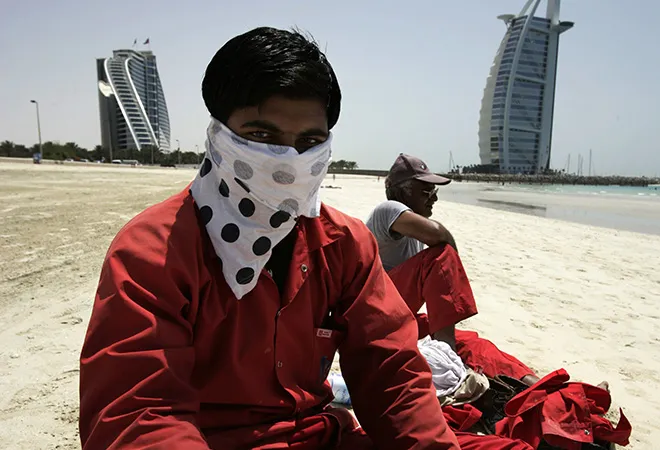-
CENTRES
Progammes & Centres
Location

The dual challenge of population lockdowns and low oil prices has set in motion economic, social, and political dynamics that cut at the heart of the debate over foreign workers in the Gulf. To reduce costs and provide jobs for their own nationals, the Arab Gulf states have resorted to laying off foreign workers in the public and private sectors. Meanwhile, the pandemic has eroded social trust between nationals and foreign workers, fuelling the perception that the demographic imbalance in favour of foreigners constitutes a security threat to the Gulf states. Since most foreign workers in the Gulf states tend to originate from South Asia, these dynamics are likely to have considerable repercussions for source countries including India, Pakistan, and Bangladesh.
Since the oil boom of the 1970s, the Gulf states have opened their borders to a massive influx of foreign workers. Today, these oil-dependent nations rely on foreign workers who constitute a majority of the workforce, ranging from 57 percent in Saudi Arabia to 95 per cent in Qatar in 2015. In four of the six Gulf states, foreigners exceed nationals as a percentage of the population, reaching up to 86 and 89 per cent in Qatar and the UAE respectively. Nationals of South Asian countries, including India, Pakistan, and Bangladesh, typically make up a majority of foreign workers in the Gulf states.
To cope with lower oil prices, the Gulf states have laid off foreign workers employed in government agencies as a means of shrinking the public wage bill or freeing up jobs for their own nationals. Oman, for instance, has ordered its state-owned enterprises to expedite replacing foreign workers by nationals. In Qatar, meanwhile, government bureaucracies and state-owned enterprises have been instructed to slash expenses related to foreign workers by 30 per cent, and in Kuwait, municipal authorities have pledged to layoff foreign workers and have them replaced with Kuwaiti nationals. State-owned enterprises, including Qatar Airways, Emirates Airlines, and Bahrain’s oil refiner BAPCO among others have also announced major job cuts affecting foreign workers.
"To cope with lower oil prices, the Gulf states have laid off foreign workers employed in government agencies as a means of shrinking the public wage bill or freeing up jobs for their own nationals"
Meanwhile in the private sector, a drop in government expenditure and weaker consumer demand have also forced private corporations to slash jobs as a means of decreasing costs. The construction sector, which tends to be overwhelmingly staffed by blue-collar foreign workers, has reportedly taken a hit as governments in the Gulf postpone a portion of their capital expenditure projects. Given restrictions on travel, the tourism industry has also suffered, producing knock-on effects in the hospitality, retail, and food and beverage sectors. To protect earnings, businesses have resorted to laying off foreign workers who do not enjoy the same levels of legal protection as nationals.
In addition to the economic dynamic, the pandemic has also generated social and political pressures in the Gulf that have strained relations between nationals and migrant workers. Because migrant workers often perform manual tasks and tend to live in densely populated camps, infection rates surged among their ranks, leading to a climate of mistrust toward them. In a few instances, migrant workers took to the streets in Kuwait and Qatar to protest unpaid wages or to demand repatriation. On occasion, these protests have descended into violence. These developments have had the combined effect of reinforcing a narrative that views migrant workers as a source of threat, amplifying political demands upon Gulf governments to remedy the demographic imbalance.
In Kuwait, efforts to pressure the government into addressing the demographic imbalance have apparently borne fruit. In June, the prime minister expressed his government’s desire to reduce the proportion of foreigners to the population from 70 to 30 per cent over the next five years. The Kuwaiti parliament has already approved a draft law that imposes quotas on foreign workers present in the country. The draft law reportedly limits the number of Indian nationals to 15 per cent of the population, implying that the Indian diaspora would have to shrink by at least 800,000 people.
But Kuwait appears as an extreme case in the Gulf, and even there, some have doubted the feasibility of the advertised reforms. In Bahrain, members of parliament have also urged the government to implement a roadmap towards decreasing the presence of foreign workers. One MP, for instance, described foreigners as a ‘time bomb about to explode. Nevertheless, the government has so far ignored such demands and has instead defended a flexi-permit scheme that allows foreign workers to sponsor themselves, indicating that it has no intention as of yet to undertake drastic reform to its labour or immigration policies.
The economic downturn, coupled with labour and immigration reforms, is likely to have considerable effects on source countries in South Asia. India, Pakistan, and Bangladesh expect to see a large uptick in reverse migration back from the Gulf. As of July 3, the Gulf states topped the list of countries from which Indians have been repatriated as part of India’s Vande Bharat mission. At least 60,000 Pakistanis and 57,000 Indians were evacuated from the UAE alone. In Bangladesh, for which remittances are the second largest source of foreign currency, nearly 100,000 Bangladeshi nationals were evacuated from the Gulf countries in the of a single month earlier this year.
In India, Kerala above all is bracing for difficult times ahead. Because up to 90 per cent of people who emigrate from the southern state end up in the Gulf states, according to the 2014 Kerala Migration Survey, Kerala is often seen as being joined to the Gulf states at the hip. Unsurprisingly, Kerala has as of 3 July received the largest number of evacuees on the Vande Bharat mission, estimated at over 94,000 or 19 per cent of total repatriations. Authorities in Kerala expect up to half a million returnees to find their way back to the state during the course of this year, although other experts place this figure at 300,000 instead.
"Authorities in Kerala expect up to half a million returnees to find their way back to the state during the course of this year, although other experts place this figure at 300,000 instead."
In either case, this would place a massive burden on the state, which had already grappled with above-average unemployment. At the height of the nationwide lockdown in May, Kerala’s unemployment figures soared to 26.5 per cent, exceeding the national average of 23.5 per cent. In addition to the state’s own challenges, the influx of returnees could in turn have spill over effects for other states such as Jharkhand, Bihar, Uttar Pradesh, and Odisha, whose own inhabitants often seek work in Kerala as guest or migrant workers. Moreover, although financial remittances from the Gulf had remained robust in the face of earlier waves of reverse migration, the expected dip by about 20 per cent in global remittances this time around, according to the World Bank, is unlikely to leave Kerala, or any of the other major sources of migration, unscathed.
With a few exceptions, leaders in India and the Gulf have largely prevented domestic economic and political pressures from spilling over into bilateral diplomatic relations. This owes to the broad scope of bilateral relations, which in recent years has expanded to include energy security, food security, cross-border investments, and cooperation in high technology, among others. Nevertheless, it is possible to envisage several scenarios – including unrest among foreign workers in the Gulf or an increase in communal violence in India – that could cause tensions to escalate. Much hinges, therefore, on how quickly India and the Gulf states recover economically and whether the situation ever returns to business as usual.
The views expressed above belong to the author(s). ORF research and analyses now available on Telegram! Click here to access our curated content — blogs, longforms and interviews.

Hasan Alhasan is a Ph.D. candidate at the India Institute at Kings College London and an Associate Fellow at the International Institute for Strategic Studies ...
Read More +